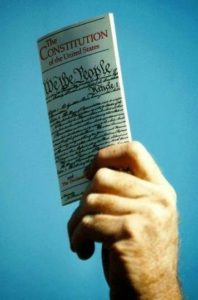Whenever a president nominates to the Supreme Court someone who pledges to apply the Constitution as written, liberal commentators emerge to explain why this is a bad idea. They claim that “originalism” — applying the Constitution as the Founders understood it — is unrealistic or extreme. Some even claim originalism is a new invention, dating only from the Reagan years.
But applying legal documents as their makers intended is the way courts and lawyers interpret most documents, and have done so since the days of the Roman Empire.
Illustrative is a March Supreme Court ruling in Washington State Department of Licensing v. Cougar Den.
Cougar Den is a fuel company owned by an Indian tribe, the Yakama Nation of Washington State. Washington imposes a tax on fuel importers who travel by public highway. The state wanted to tax Cougar Den.
However, in 1855 the Yakamas and the U.S. government entered into a treaty. Under the treaty, the tribe ceded about 10 million acres of land. In exchange the government guaranteed the tribe the right, in common with citizens of the United States, to travel upon all public highways. The tribe claimed this language exempted its fuel enterprise from the tax.
In response, Washington State argued that the treaty language prevented the state only from taxing Cougar Den more than it taxed other fuel import companies.
So the court had to interpret the treaty’s language. Taken out of historical context, the effect of the language was not clear. It called for interpretation. Did the court apply a living theory of interpretation? No. It sought the original understanding behind the treaty.
In fact, the court’s principal opinion is an exemplar of originalist method. Justice Stephen Breyer authored it, and Justices Sotomayor and Kagan signed onto it. All three are considered among the court’s more liberal members.
Breyer wrote that the language of the treaty should be understood as bearing the meaning that the Yakimas understood it to have in 1855. He then reviewed the evidence to determine what that understanding was.
He pointed out that the treaty was written in English. In 1855 the Yakimas generally knew little English, but both sides emphasized that the Yakimas needed to protect their freedom to travel. In persuading the tribe to sign the instrument, Breyer wrote, “U.S. representatives repeatedly reassured the Yakamas that under the treaty the Yakamas would be able to travel outside their reservation on the roads that the United States built.” Breyer concluded that state taxation illegally burdened the tribe’s treaty right.
![]() Justice Neil Gorsuch concurred with Breyer: “Our job is a modest one,” he wrote. “We are charged with adopting the interpretation most consistent with the treaty’s original meaning … We must give effect to the terms as the Indians themselves would have understood them … After all, the United States drew up this contract, and we normally construe any ambiguities against the drafter who enjoys the power of the pen.”
Justice Neil Gorsuch concurred with Breyer: “Our job is a modest one,” he wrote. “We are charged with adopting the interpretation most consistent with the treaty’s original meaning … We must give effect to the terms as the Indians themselves would have understood them … After all, the United States drew up this contract, and we normally construe any ambiguities against the drafter who enjoys the power of the pen.”
Like Breyer, Gorsuch examined the historical circumstances. He considered (1) representations the government negotiators made to the tribe, (2) details of the Yakama language, and (3) the large size of the tribe’s land grants. Justice Ruth Bader Ginsburg concurred with Gorsuch. (The four dissenting justices did not dispute this originalist approach; they disagreed on other grounds.)
This case illustrates how judges apply originalism for almost all legal documents — except the Constitution. Originalism also was the prevailing judicial practice during the founding era, and the founders expected future generations to interpret the Constitution that way. And so future generations did — for 150 years, until constitutional adjudication became corrupted in the 20th century.
Just as a treaty drafted by the government and accepted by the tribe is applied as the tribe understood it, a Constitution drafted by a convention should be applied as its ratifiers understood it. For both, evidence for recovering the original understanding includes the text, how language was used at the time of adoption, how advocates represented its meaning, and other surrounding circumstances.
The only real difference is that those who ratified the Constitution knew English better than the 1855 Yakamas, so we can be more confident the Constitution’s text reflects the ratifiers’ understanding.
There is nothing new or unique about originalism. It is just standard legal interpretation — and the only method of constitutional interpretation fully consistent with the rule of law.
Rob Natelson served as a law professor for 25 years, and nationally known as a constitutional scholar. He is Senior Fellow in Constitutional Jurisprudence at the Independence Institute in Denver, and author of The Original Constitution: What It Actually Said and Meant (3rd ed. 2014). A version of this article first appeared in The Daily Caller.


